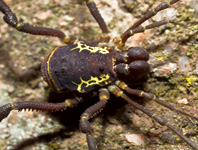Abstract
Eight species are recognised in the Aphanius dispar group. Aphanius dispar from the Red and Mediterranean Sea basins, A. stoliczkanus from coastal areas of the Arabian/Persian Gulf, the northern Arabian Sea east to Gujarat in India, the Gulf of Oman and some endorheic basins in Iran and Pakistan, A. richardsoni from springs in the Dead Sea basin in Jordan and Israel, A. sirhani from the Azraq Oasis in Jordan, A. ginaonis from one spring in Iran, A. furcatus from few streams and springs in Iran and A. stiassnyae from one lake in Ethiopia. Aphanius kruppi, new species, from the Wadi al Batha drainage in northern Oman, is distinguished from adjacent A. stoliczkanus by having 9–14 brown or grey lateral bars on the flank in the male, a roundish, diamond-shaped or somewhat vertically-elongate blotch centred on the caudal-fin base in the female and 2–3 scale rows on the caudal-fin base. The available molecular genetic data for A. dispar reject the hypothesis of the presence of a single widespread coastal species in the Middle East and make it likely that two additional unidentified species occur in the Red Sea basin.
References
Ben-Tuvia, A. (1985) The impact of the Lessepsian (Suez Canal) fish migration on the Eastern Mediterranean ecosystem. In: Moraitou-Apostolopoulou, M. & Kiortsis, V. (Eds.), Mediterranean Marine Ecosystems. NATO Conference Series (I Ecology). Vol. 8. Springer, Boston, MA, pp. 367–375
Biomatters (2013) Geneious Pro. Available from: http://www.geneious.com (accessed 19 September 2017)
Day, F. (1872) Notes on fish, collected by Dr. Stoliczka in Kachh. Journal of the Asiatic Society of Bengal, 41 (2), 1–4, 258–260.
Edgar, R.C. (2004) MUSCLE: multiple sequence alignment with high accuracy and high throughput. Nucleic acids research, 32, 1792–1797.
https://doi.org/10.1093/nar/gkh340Galil, B.S. (2007) Loss or gain? Invasive aliens and biodiversity in the Mediterranean Sea. Marine Pollution Bulletin, 55, 314–322.
https://doi.org/10.1016/j.marpolbul.2006.11.008Geiger, M.F., Herder, F., Monaghan, M.T., Almada, V., Barbieri, R., Bariche, M., Berrebi, P., Bohlen, J., Casal-Lopez, M., Delmastro, G.B., Denys, G.P.J., Dettai, A., Doadrio, I., Kalogianni, E., Kärst, H., Kottelat, M., Kovačić, M., Laporte, M., Lorenzoni, M., Marčić, Z., Özuluğ, M., Perdices, A., Perea, S., Persat, H., Porcelotti, S., Puzzi, C., Robalo, J., Šanda, R., Schneider, M., Šlechtová, V., Stoumboudi, M., Walter, S., & Freyhof, J. (2014) Spatial heterogeneity in the Mediterranean Biodiversity Hotspot affects barcoding accuracy of its freshwater fishes. Molecular Ecology Resources, 14, 1210–1221. https://doi.org/10.1111/1755-0998.12257
Getahun, A. & Lazara, K.J. (2001) Lebias stiassnyae: a new species of killifish from Lake Afdera, Ethiopia (Teleostei: Cyprinodontidae). Copeia, 1, 150–153.
https://doi.org/10.1643/0045-8511(2001)001[0150:LSANSO]2.0.CO;2Goren, M. (1974) The freshwater fishes of Israel. Israel Journal of Zoology, 23, 67–118.
Ivanova, N.V., Zemlak, T.S., Hanner, R.H. & Hebert, P.D.N. (2007) Universal primer cocktails for fish DNA barcoding. Molecular Ecology Notes, 7, 544–548.
https://doi.org/10.1111/j.1471-8286.2007.01748.xKapli, P., Lutteropp, S., Zhang, J., Kobert, K., Pavlidis, P., Stamatakis, A. & Flouri, T. (2016) Multi-rate Poisson Tree Processes for single-locus species delimitation under Maximum Likelihood and Markov Chain Monte Carlo. bioRxiv, 063875, 1–8. [published online]
https://doi.org/10.1101/063875Lyon, R.G., Geiger, M.F. & Freyhof, J. (2016) Garra sindhi, a new species from the Jebel Samhan Nature Reserve in Oman (Teleostei: Cyprinidae). Zootaxa, 4154 (1), 79–88.
https://doi.org/10.11646/zootaxa.4154.1.5Kimura M. (1980) A simple method for estimating evolutionary rate of base substitutions through comparative studies of nucleotide sequences. Journal of Molecular Evolution, 16, 111–120.
https://doi.org/10.1007/BF01731581Kottelat, M. & Freyhof, J. (2007) Handbook of European freshwater fishes. Kottelat, Cornol & Freyhof, Berlin, xiv + 646 pp.
Krupp, F. (1988) Freshwater fishes of the Wadi Batha drainage. Journal of Oman Studies Special Report, 3, 401–404.
Maizels, J.K. (1987) Plio-Pieistocene raised channel systems of the western Sharqiya (Wahiba), Oman. In: Frostick, L. & Reid, I. (Eds.) Desert sediments: Ancient and Modern. Geological Society Special Publication, 35, pp. 31–50
Masters, B.C., Fan, V. & Ross, H.A. (2011) Species delimitation – a geneious plugin for the exploration of species boundaries. Molecular Ecology Resources, 11, 154–157.
https://doi.org/10.1111/j.1755-0998.2010.02896.xPosada, D. & Crandall, K.A. (1998) MODELTEST: testing the model of DNA substitution. Bioinformatics, 14, 817–818.
https://doi.org/10.1093/bioinformatics/14.9.817Reichenbacher, B., Feulner, G.R. & Schulz-Mirbach, T. (2009) Geographic variation in otolith morphology among freshwater populations of Aphanius dispar (Teleostei, Cyprinodontiformes) from the Southeastern Arabian Peninsula. Journal of Morphology, 270, 469–484.
https://doi.org/10.1002/jmor.10702Rüppell, E. (1829) Atlas zu der Reise im nördlichen Afrika. Fische des rothen Meers. Gedruckt und in Commission bei Heinr. Ludw. Brönner, Frankfurt am Main, 141 pp.
Saitou, N. & Nei, M. (1987) The neighbor-joining method: a new method for reconstructing phylogenetic trees. Molecular Biology and Evolution, 4 (4), 406–425.
Swofford, D.L. (2002) PAUP*. Phylogenetic Analysis Using Parsimony (*and Other Methods). Version 4. Sinauer Associates, Sunderland. MA. [software]
Tamura, K., Stecher, G., Peterson, D., Filipski, A. & Kumar, S. (2013) MEGA6: Molecular Evolutionary Genetics Analysis version 6.0. Molecular Biology and Evolution, 30, 2725–2729.
https://doi.org/10.1093/molbev/mst197Teimori, A., Esmaeili, H.R., Erpenbeck, D. & Reichenbacher, B. (2014) A new and unique species of the genus Aphanius Nardo, 1827 (Teleostei: Cyprinodontidae) from southern Iran: a case of regressive evolution. Zoologischer Anzeiger, 253, 327–337.
https://doi.org/10.1016/j.jcz.2013.12.001Teimori, A., Jawad, L.A.J., Al-Kharusi, L.H., Al-Mamry, J.M. & Reichenbacher, B. (2012) Late Pleistocene to Holocene diversification and historical zoogeography of The Arabian killifish (Aphanius dispar) inferred from otolith morphology. Scientia Marina, 76, 637–645.
Teimori, A., Motamedi, M. & Askari Hesni, M. (2016) Fish morphology and mitochondrial phylogeny reveal translocations of a native Aphanius Nardo, 1827 (Teleostei: Cyprinodontidae) in Iran. Iranian Journal of Ichthyology, 3, 181–189.
https://doi.org/10.7508/iji.2016Villwock, W. (1985) Über Naturbastarde zwischen zwei validen Arten der Gattung Aphanius (Nardo, 1827) (Pisces, Cyprinodontidae) aus der Bardawil-Lagune, Nordsinai/Ägypten. Mitteilungen aus dem Hamburgischen Zoologischen Museum und Institut, 82, 311–317.
Villwock, W., Scholl, A. & Krupp, F. (1983) Zur Taxonomie, Verbreitung und Speziation des Formenkreises Aphanius dispar (Rüppell, 1828) und Beschreibung von Aphanius sirhani n. sp. (Pisces: Cyprinodontidae). Mitteilungen aus dem Hamburgischen Zoologischen Museum und Institut, 80, 251–277.
Zhang, J., Kapli, P., Pavlidis, P. & Stamatakis, A. (2013) A general species delimitation method with applications to phylogenetic placements. Bioinformatics, 29 (22), 2869–2876.
https://doi.org/10.1093/bioinformatics/btt499

